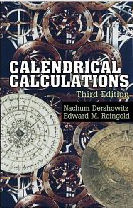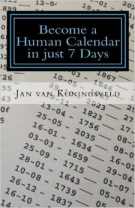One Century
The Rules
The general rules for
calculating records apply.
- The record is for finding the correct days of the week from 20
random dates from the whole century.
- The calculator should perform the calculation in his/her head
without the aid of any other person and without using a
calculating machines, computers, etc.
- 20 dates of the current century must be randomly selected by
computer or by taking lottery tickets, but not by
writing down dates at the referee's direction or dates of birth.
Every day of the century must have the same chance to be chosen
(including the 29th February in every 4th year).
- The dates must be written down to a list. The record breaker
must not look at this list until the record starts.
Alternatively, a computer can be used for displaying the tasks
and also for taking the time needed by the competitor.
- After the referee has started the attempt and two independent
stop watches have been started, the record breaker finds the
days of the week for all dates in the list.
- The method of identifying the dates is optional but the
following methods may be considered:
- A system of buttons or buzzers may be employed with, for
example, button 1 representing Monday, button 2 Tuesday and on
on - the competitor presses the appropriate button to record
his/her answer for each date in succession. Only one attempt
may be made to identify each date.
- The competitor may write down his/her answers to each date
in order. Only one answer may be made to identify each date.
- The competitor may record his/her answers electronically.
Only one answer may be made to identify each date.
- Two stopwatches should be used. The timing begins when the
dates become visible to the competitor and ends at the end of
writing / speaking the last answer. At the end of the attempt
the time should be taken as an average of the two watches.
- A new record can be set only if there are NO ERRORS. (This
must be checked when the record attempt is over.) If the record
breaker speaks the days of the week instead of writing them
down, the record attempt must be recorded on a tape.
World Records
(new records will be accepted for 20 dates only!)
03-06-1993 Dany Sirejean (France) 18 dates / 48 sec
03-05-1997 Luc Rouleau (Canada) 20 dates / 35 sec
09-11-2003 Matthias Kesselschläger (Germany) 20 dates / 24.94 sec
31-10-2005 Yusnier Viera Romero (Cuba) 20 dates / 23.2 sec
31-10-2005 Yusnier Viera Romero (Cuba) 20 dates / 19.8 sec
06-11-2005 Matthias Kesselschläger (Germany) 20 dates / 17.9 sec
12-03-2010 Jan van Koningsveld (Germany) 20 dates / 17.42 sec
12-03-2010 Jan van Koningsveld (Germany) 20 dates / 17.03 sec
12-03-2010 Jan van Koningsveld (Germany) 20 dates / 16.61 sec
12-03-2010 Jan van Koningsveld (Germany) 20 dates / 16.16 sec
5-06-2010 Freddis Reyes Hernandez (Cuba) 20 dates / 13.47 sec
7-06-2010 Freddis Reyes Hernandez (Cuba) 20 dates / 13.30 sec
7-06-2010 Freddis Reyes Hernandez (Cuba) 20 dates / 12.72 sec
4-12-2010 Yusnier Viera Romero (Cuba) 20 dates / 10.76 sec
4-12-2010 Yusnier Viera Romero (Cuba) 20 dates / 10.44 sec
4-12-2010 Yusnier Viera Romero (Cuba) 20 dates / 9.37 sec
4-12-2010 Yusnier Viera Romero (Cuba) 20 dates / 9.04 sec
4-12-2010 Yusnier Viera Romero (Cuba) 20 dates / 8.05 sec
PC-Program to find random dates
If you want to break this record, you can find a program for
generating date lists here.
One Year
The Rules
The general rules for
calculating records apply.
- The record is for finding the correct days of the week from
all 365 or 366 dates from the current year.
- The calculator should perform the calculation in his/her head
without the aid of any other person and without using a
calculating machines, computers, etc.
- All dates of the current year must be written down in random
order (selected by computer or by taking lottery tickets, but not
by writing down dates at the referee's direction). The record
breaker must not look at this list until the record starts.
Alternatively, a computer can be used for displaying the tasks
and also for taking the time needed by the competitor.
- After the referee has started the attempt and two independent
stop watches have been started, the record breaker finds the
days of the week for all dates in the list.
- The method of identifying the dates is optional but the
following methods may be considered:
- A system of buttons or buzzers may be employed with, for
example, button 1 representing Monday, button 2 Tuesday and on
on - the competitor presses the appropriate button to record
his/her answer for each date in succession. Only one attempt
may be made to identify each date.
- The competitor may write down his/her answers to each date
in order. Only one answer may be made to identify each date.
- The competitor may record his/her answers electronically.
Only one answer may be made to identify each date.
- Two stopwatches should be used. The timing begins when the
dates become visible to the competitor and ends at the end of
writing / speaking the last (365th or 366th)
answer. At the end of the attempt the time should be taken as an
average of the two watches.
- A new record can be set only if there are NO ERRORS. (This
must be checked when the record attempt is over.) If the record
breaker speaks the days of the week instead of writing them
down, the record attempt must be recorded on a tape.
World Records
26-06-1982 Ilse Kirsch (Germany) 431 sec
28-01-1983 Ilse Kirsch (Germany) 348 sec
28-04-1983 Ilse Kirsch (Germany) 309 sec
28-04-1983 Ilse Kirsch (Germany) 293 sec
29-03-1984 Ilse Kirsch (Germany) 248 sec
16-11-1984 Ilse Kirsch (Germany) 230 sec
05-09-1985 Ilse Kirsch (Germany) 227 sec
08-10-1994 Ralf Laue (Germany) 222 sec
09-11-2003 Matthias Kesselschläger (Germany) 218 sec
06-11-2005 Matthias Kesselschläger (Germany) 214 sec
4-12-2010 Yusnier Viera Romero (Cuba) 191.4 sec
24- 9-2011 Yusnier Viera Romero (Cuba) 170.2 sec
31-10-2015 Yusnier Viera Romero (USA) 161.3 sec
27-01-2018 Yusnier Viera Romero (USA) 150.4 sec
1600-2100, one minute
The Rules
The general rules for
calculating records apply.
The record is for the greatest number of days of the week
correctly identified from random dates in one minute.
- Dates between 1 January 1600 and 31 December 2100 are selected
at random by computer immediately prior to the challenge.
- The dates should be presented to the competitor(s) either on a
sheet of paper. Alternatively, a computer can be used for
displaying the tasks and also for taking the time needed by the
competitor.
- Dates should be shown digitally, thus 14 June 1947 should
appear as 14-6-1947 or 14/6/1947 or similar.
- If a screen is used, all the dates should appear
simultaneously to the competitor(s) on the screen. Whatever
system is used to record answers (see below), all the
dates are shown one after another simultaneously to the
competitor - if dates are shown one after another the speed at
which each competitor works would be artificially slowed.
- The competitor(s) should identify which day of the week the
dates were. This must be done in the order in which the dates
are listed.
- One minute is allowed for the challenge. An experienced
timekeeper should keep the time with an accurate stopwatch.
Alternatively, a computer system can do the timing.
- The timing begins when the dates become visible to the
competitor(s).
- The method of identifying the dates is optional but the
following methods may be considered:
- A system of buttons or buzzers may be employed with, for
example, button 1 representing Monday, button 2 Tuesday and on
on - the competitor presses the appropriate button to record
his/her answer for each date in succession. Only one attempt
may be made to identify each date.
- The competitor may write down his/her answers to each date
in order. Only one answer may be made to identify each date.
- The competitor may record his/her answers electronically.
Only one answer may be made to identify each date.
- Only correct answers count towards the total. If more than one
incorrect answer is given by a competitor his/her attempt is
nullified.
- the name of the person making the attempt should be given,
along with the date and place.
World Records
09-04-1999 Ralf Laue (Germany) 14
03-10-1999 Stephan Gruber (Germany) 19
26-11-1999 Gert Mittring (Germany) 20
27-10-2002 Stephan Gruber (Germany) 22
09-11-2003 Matthias Kesselschläger (Germany) 32
30-10-2004 Matthias Kesselschläger (Germany) 33
31-10-2005 Yusnier Viera Romero (Cuba) 42
06-11-2005 Matthias Kesselschläger (Germany) 45
18-12-2006 Yusnier Viera Romero (Cuba) 53
18-12-2006 Yusnier Viera Romero (Cuba) 56
2-11-2008 Jan van Koningsveld (Germany) 56
5-12-2009 Yusnier Viera Romero (Cuba) 59
12-03-2010 Jan van Koningsveld (Germany) 63
12-03-2010 Jan van Koningsveld (Germany) 66
12-03-2010 Jan van Koningsveld (Germany) 69
12-03-2010 Jan van Koningsveld (Germany) 70
5-06-2010 Freddis Reyes Hernandez (Cuba) 73
5-06-2010 Freddis Reyes Hernandez (Cuba) 74
7-09-2010 Jan van Koningsveld (Germany) 78
4-12-2010 Yusnier Viera Romero (Cuba) 91
4-12-2010 Yusnier Viera Romero (Cuba) 93
24-10-2015 Jan van Koningsveld (Germany) 96
31-10-2015 Yusnier Viera Romero (USA) 103
31-10-2015 Yusnier Viera Romero (USA) 111
9-11-2016 Jay Baldiya Jain (India) 125
27-01-2018 Yusnier Viera Romero (USA) 132
27-01-2018 Yusnier Viera Romero (USA) 140
9-03-2924 Yusnier Viera Romero (USA) 148
9-03-2924 Yusnier Viera Romero (USA) 159
Back to the World Record Homepage,
Back to "Members and Records"

